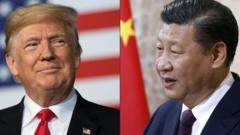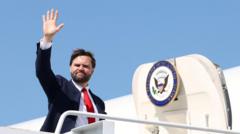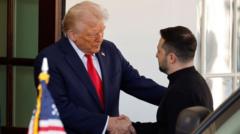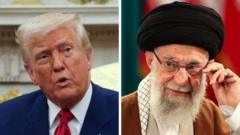A new wave of discussions on US-China tariffs emerges as both nations engage in a high-stakes game of diplomatic chicken. While tensions simmer, the question looms: who will be the first to blink?
The Stalemate in US-China Trade Talks: Who Will Yield First?

The Stalemate in US-China Trade Talks: Who Will Yield First?
Amid escalating tariffs, both the US and China appear hesitant to initiate trade negotiations, raising questions about the future of their economic relationship.
In a dramatic turn of events, discussions surrounding the contentious trade relations between the US and China have resurfaced. On Friday, China’s Ministry of Commerce released a statement indicating a possible reassessment of tariff talks with the United States. The global community has been eagerly anticipating this development, given that exorbitant tariffs—some climbing to an astonishing 245% on certain Chinese exports—are heavily impairing trade between the two economic giants and raising fears of an impending recession.
"US officials have shown a willingness to negotiate," the spokesperson emphasized during a press briefing. "China's stance remains pragmatic: if we're to engage, we will do so under the premise that the US must first demonstrate sincerity by addressing its unilateral tariff decisions."
The announcement follows a series of conflicting reports on social media, partially fueled by a Weibo account affiliated with Chinese state media, asserting that the US has sought to initiate formal discussions. This statement counters President Trump’s previous claims that negotiations were already in motion—a notion that Beijing swiftly denied. In a post, the Weibo account stated, "China has no impetus to engage with the US; currently, the US appears more desperate for dialogue."
This ongoing back-and-forth between both nations presents itself like a game of chicken, where neither leader—Trump or Xi Jinping—wants to appear weak. Experts suggest that both are reluctant to initiate talks first, as it would be perceived as conceding ground in a political landscape where maintaining domestic support is vital.
“Neither Washington nor Beijing wants to present themselves as the party that gives in,” commented Ja Ian Chong, a political science professor at the National University of Singapore. “However, mutual de-escalation benefits both sides, providing an overarching incentive to pursue negotiation.”
Other academics have likened the situation to two racing cars on a collision course—where the first to swerve risks being labeled the loser of the encounter. “The leader that first approaches in an effort to calm tensions could be viewed as less formidable in the eyes of their constituents,” analyzed Wen-Ti Sung from the Australian Centre on China in the World.
This current state of affairs is marked by "constructive ambiguity," wherein both parties utilize vague language to assert their positions while diplomatically maneuvering towards de-escalation. Sung posits, "Beijing seems to be attempting to leverage ambiguous language to create an opportunity for both parties to retreat from the current tensions."
Options for both nations could involve third-party mediation or a looser understanding of outreach, facilitating dialogue without apparent admissions of defeat. Achieving a successful negotiation would also hinge on demonstrating to their respective bases a semblance of victory in the ongoing discourse.
Domestically, Trump and Xi are under pressure to exhibit accomplishments to their supporters. With recent data indicating a contraction in the US economy, President Trump is tasked with easing recession fears. Conversely, Xi faces the challenge of assuring an anxious public amidst high unemployment and a crumbling property sector.
Experts agree that this trade war will not yield a simplistic win-lose scenario, as both leaders acknowledge that a zero-sum outcome is no longer realistic. “Accords will likely involve concessions on both sides, carving out space for them to each claim a semblance of triumph," noted Sung.
As it stands, both nations appear to be in a precarious ballet of negotiation without any actionable results in sight. Observations indicate that despite confirmations of dialogues taking place, significant obstacles remain before any constructive discussions materialize.
Ultimately, whether the US or China blinks first lies shrouded in uncertainty, leaving analysts watching keenly as both sides search for a pathway out of this intricate stalemate.
"US officials have shown a willingness to negotiate," the spokesperson emphasized during a press briefing. "China's stance remains pragmatic: if we're to engage, we will do so under the premise that the US must first demonstrate sincerity by addressing its unilateral tariff decisions."
The announcement follows a series of conflicting reports on social media, partially fueled by a Weibo account affiliated with Chinese state media, asserting that the US has sought to initiate formal discussions. This statement counters President Trump’s previous claims that negotiations were already in motion—a notion that Beijing swiftly denied. In a post, the Weibo account stated, "China has no impetus to engage with the US; currently, the US appears more desperate for dialogue."
This ongoing back-and-forth between both nations presents itself like a game of chicken, where neither leader—Trump or Xi Jinping—wants to appear weak. Experts suggest that both are reluctant to initiate talks first, as it would be perceived as conceding ground in a political landscape where maintaining domestic support is vital.
“Neither Washington nor Beijing wants to present themselves as the party that gives in,” commented Ja Ian Chong, a political science professor at the National University of Singapore. “However, mutual de-escalation benefits both sides, providing an overarching incentive to pursue negotiation.”
Other academics have likened the situation to two racing cars on a collision course—where the first to swerve risks being labeled the loser of the encounter. “The leader that first approaches in an effort to calm tensions could be viewed as less formidable in the eyes of their constituents,” analyzed Wen-Ti Sung from the Australian Centre on China in the World.
This current state of affairs is marked by "constructive ambiguity," wherein both parties utilize vague language to assert their positions while diplomatically maneuvering towards de-escalation. Sung posits, "Beijing seems to be attempting to leverage ambiguous language to create an opportunity for both parties to retreat from the current tensions."
Options for both nations could involve third-party mediation or a looser understanding of outreach, facilitating dialogue without apparent admissions of defeat. Achieving a successful negotiation would also hinge on demonstrating to their respective bases a semblance of victory in the ongoing discourse.
Domestically, Trump and Xi are under pressure to exhibit accomplishments to their supporters. With recent data indicating a contraction in the US economy, President Trump is tasked with easing recession fears. Conversely, Xi faces the challenge of assuring an anxious public amidst high unemployment and a crumbling property sector.
Experts agree that this trade war will not yield a simplistic win-lose scenario, as both leaders acknowledge that a zero-sum outcome is no longer realistic. “Accords will likely involve concessions on both sides, carving out space for them to each claim a semblance of triumph," noted Sung.
As it stands, both nations appear to be in a precarious ballet of negotiation without any actionable results in sight. Observations indicate that despite confirmations of dialogues taking place, significant obstacles remain before any constructive discussions materialize.
Ultimately, whether the US or China blinks first lies shrouded in uncertainty, leaving analysts watching keenly as both sides search for a pathway out of this intricate stalemate.



















